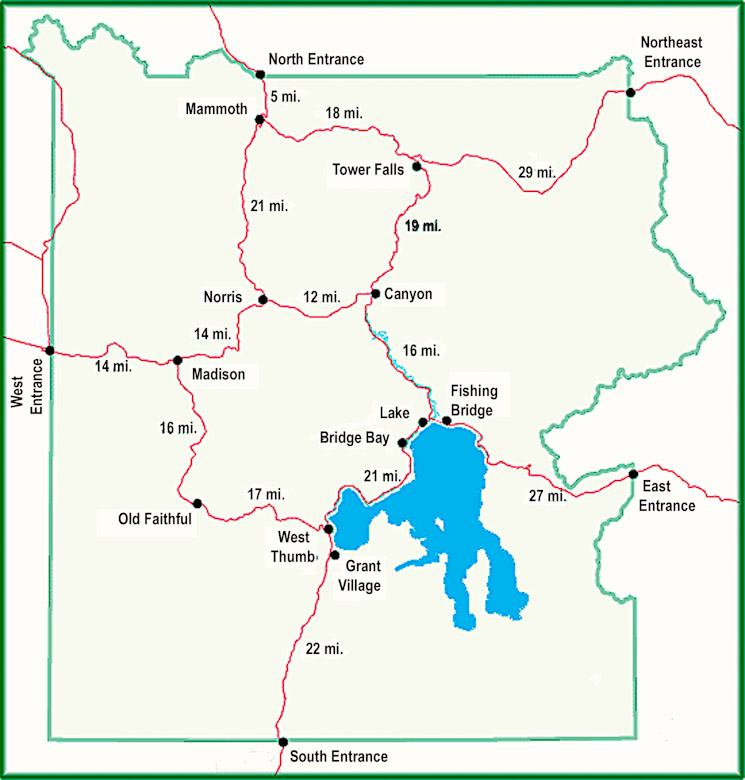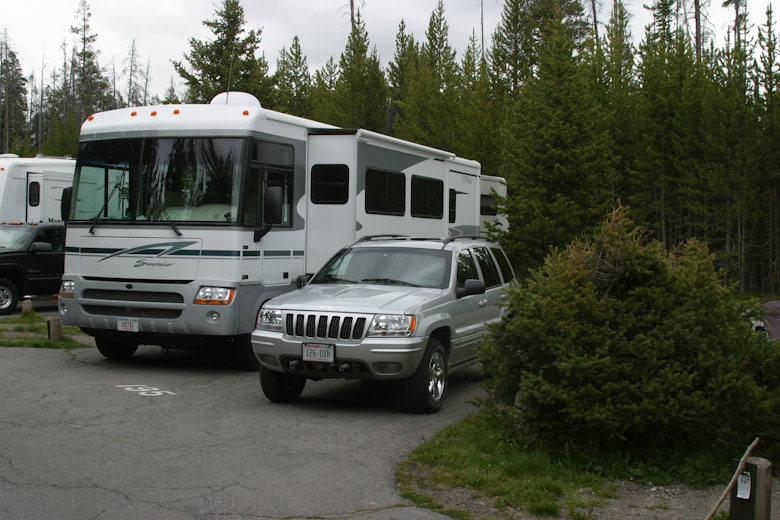Exploring Yellowstone by RV
Navigating Your RV Safely Inside America's Oldest National Park
Article Date: May, 2011
Article and Photography by Mark Quasius

Roads In Yellowstone
Okay, now you know how to get to the park. What about how to get around in the park. Yellowstone has lots of tourists.
There are a large number of areas of interest and the wildlife walks wherever it wants to and creates traffic jams too. So, you don't want to
take your RV sightseeing. Use it as your base camp and take the toad to do your sightseeing. You're never going to be able to find a place to
park a large RV in this park. However, all of the roads inside the park are navigable by RVs, with the exception of one.

The above map gives you an idea of the layout of Yellowstone's roads. They are laid out in a figure eight with five connecting
roads radiating out of the park through the various entrances. If you add up the mileage of these roads you'll see that there can be quite a bit of
driving involved to get to the various areas of the park so you'll want to plan your base camp locations accordingly to minimize that drive time.
I prefer to split that time by staying in two different areas and that gives us more time to explore nearby regions rather than drive a large portion
of the day just to get there. Although, some of the best surprises we've had were on those unexpected drives. As mentioned earlier, all of the roads
are navigable by large RVs with the exception of one. That would be the 19 mile run between Tower Falls and Canyon. This road climbs Mount Washburn
via Dunraven Pass. The road has recently been repaved on Mount Washburn and the new blacktop is nice. However, there are very tight turns as the road
clings to the side of the mountain. It's going to be near impossible to keep a long motorhome that doesn't bend in the middle in your own lane. Couple
that with the fact that most oncoming drivers with minivans can't seem to stay in their own lane, throw in a ton of blind curves around cliffs, and
you have a real recipe for an exciting time. That's the one road in the park I won't drive in my RV. A major campaign was implemented over the last
20 years to repair Yellowstone's roads. The many potholed, narrow roads have now been upgraded to smooth, wider asphalt roads with additional pull-off
areas and are much better suited for large RVs. The last segment, currently in process, is the Gibbon Falls area between Norris and Canyon, but it too
is passable in it's present state.
Camping In and Around Yellowstone
Yellowstone is all about nature. Therefore the campgrounds that you find inside the park won't be the best for large RVs.
The only RV park inside Yellowstone with full hook-ups is Fishing Bridge Campground. It was built a long time ago and has 30 amp electric service plus
water and sewer. Many have described it as a large parking lot because the RVs are packed in pretty tight. The sites are all back-ins and they aren't
that long. There are a few sites capable of handling a 40' motorhome but not that many. Your toad will be parked right next to the RV. The site
immediately behind you is staggered so that their RV backs to your toad and your toad backs to their RV. There are shrubs to separate your site from
the one next to you. These shrubs were placed next to these narrow sites before slide-outs were invented. You'll undoubtedly find that it's going to be
very difficulty to extend your slides on a 40' quad slide coach without scratching them up on the dry shrubbery. However, it's the only site in the
park with full hook-ups. The majority of the other campgrounds won't even have a dump station, although there are exceptions. For more details on
Yellowstone's campgrounds check out the website at
http://www.nps.gov/yell/planyourvisit/camping-in-yellowstone.htm for more details. Fishing Bridge also has a great location, close to Hayden Valley
and Yellowstone Lake so if you have a smaller RV you may find the area a strategic location to explore that area of the park from. The parking lot
atmosphere may be overlooked because you won't be sitting around your RV anyway. Instead you'll be touring the park and only using the RV as
sleeping quarters.

Typical Fishing Bridge campsite.
Mammoth has the only campground that is open year round. That's because it's on the only road that is open year round. It
has no water, electricity, or sewer so you will strictly be dry camping. Unlike Madison, Grant, and Bridge bay - there is no dump station either.
It is a roomy campground though so if you are coming in from the north entrance it is an option if you don't mind boondocking. It's a great location
for the fall elk rut.
If you would rather stay outside of the park and take the toad in, you have some better options. A number of private
campgrounds feature full hookups. Staying in Gardiner gives you access to the Mammoth area while staying in West Yellowstone gives you easy
access to Madison, Norris, and Old Faithful. It's also centrally located so shuttling across to Canyon and Fishing Bridge isn't all that bad,
although base camping in Fishing Bridge is always an ideal location. Note that there are no campgrounds by the ever popular Old Faithful area.
The closest is the no hookups campground at Madison or the full service campgrounds outside the park at West Yellowstone.
There are no full service campgrounds outside the northeast entrance or east entrance. The closest to the east entrance
is Cody, WY while the closest to the northeast entrance would be the campground in Sunlight Basin or else Red Lodge, MT.
For the official detailed map of Yellowstone National Park check out the following link -
docs/yellmap.pdf.
Grand Teton National Park

You'll cross the Continental Divide three times if trasveling between Yellowstone and the Tetons.
Many RVers visiting Yellowstone also visit Grand Teton National Park to the south. Leaving Yellowstone via the south
entrance takes you directly into that park. An easy, but scenic drive takes you over the gentle roller coaster hills of Yellowstone's southern
extremes and out onto the Snake River plateau where you'll see Jackson Lake at the foot of the Teton Range. Continuing on through the park on
US-89 will take you to Jackson, WY. Jackson is a good place to base camp and an interesting town with plenty of western atmosphere and any
kind of upscale shopping and dining you could possibly imagine. To see the Tetons you can stay at Jackson or you can also find a private park
just east of the Tetons at Moran Junction. To stay in the park you are limited to Flagg Ranch, Colter Bay, or Gros Ventre campgrounds and
most will not have hookups.
After you are done with the Tetons you can exit to the north, east, or south. The north will take you back to Yellowstone,
where you came from. Heading east from Moran Junction will take you over Togwottee Pass and then parallels the Wind River Range. Togwottee Pass is
not a problem for RVs so there's nothing to be concerned about. US-26 and US-287 run this very scenic route and eventually split off with US-287
heading south to Lander and eventually I-80 while US-26 heads up to Riverton, Thermopolis, and Buffalo and eventually I-90. If you exit the
Tetons to the south you can take a number of routes, US-189, US-191, or US-89 - depending on where you want to wind up. The only deal breaker
would be to take WY-22 west from Jackson which takes you over the steep and winding Teton Pass before dumping you out in Driggs, ID. That's one
pass you may want to reconsider with a large RV.
Return to Home Page
If you enjoyed this article be sure to recommend RVtechMag.com to your friends, like us on Facebook or Twitter
or subscribe to our RSS feed.



|








